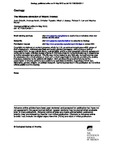The Miocene elevation of Mount Everest

Date
2013-07-01Author
Metadata
Show full item recordAbstract
The Neogene elevation history of the Mount Everest region is key for understanding the tectonic history of the world's highest mountain range, the evolution of the Tibetan Plateau, and climate patterns in East and Central Asia. In the absence of fossil surface deposits such as paleosols, volcanic ashes, or lake sediments, we conducted stable isotope paleoaltimetry based on the hydrogen isotope ratios (δ D) of hydrous minerals that were deformed in the South Tibetan detachment shear zone during the late Early Miocene. These minerals exchanged isotopically at high temperature with meteoric water (δ D water = 156% ± 5%) that originated as high-elevation precipitation and infi ltrated the crustal hydrologic system at the time of detachment activity. When compared to age-equivalent near-sea-level foreland oxygen isotope (δ 18O) paleosol records (δ 18Owater = 5.8% ± 1.0%), the difference in δ18Owater is consistent with mean elevations of ≥5000 m for the Mount Everest area. Mean elevations similar to modern suggest that an early Himalayan rain shadow may have infl uenced the late Early Miocene climatic and rainfall history to the north of the Himalayan chain. © 2013 Geological Society of America.
Collections
Journal
Volume
Issue
Pagination
Recommended, similar items
The following license files are associated with this item:

